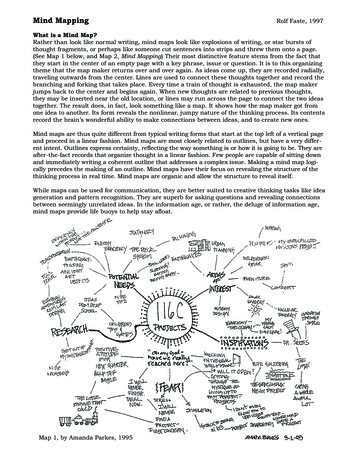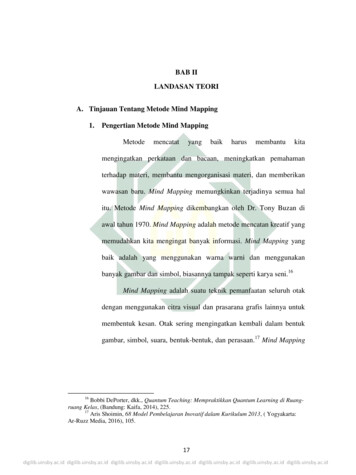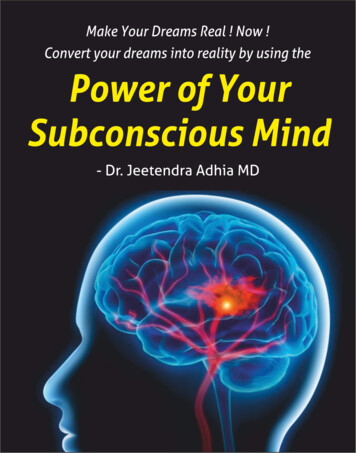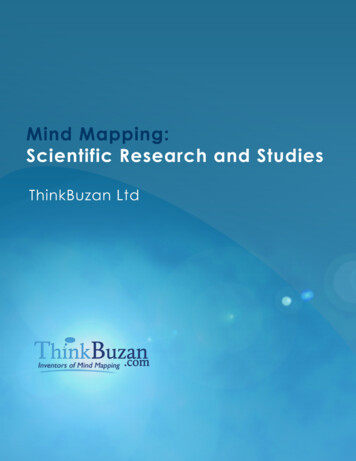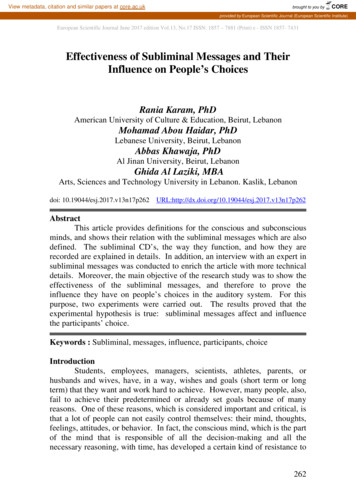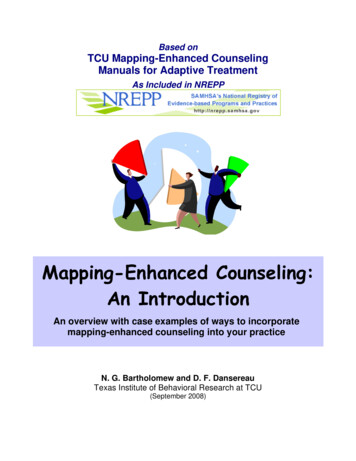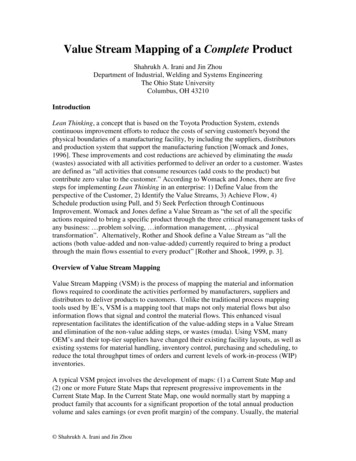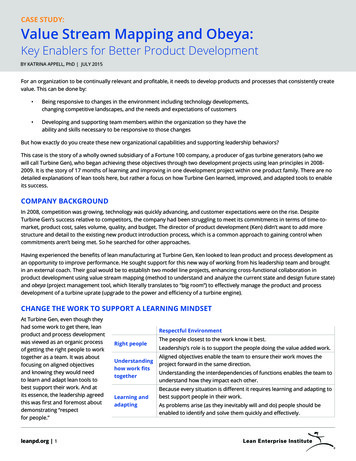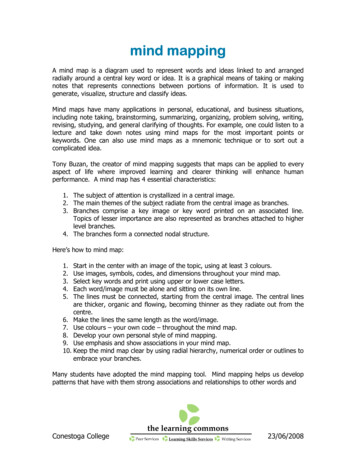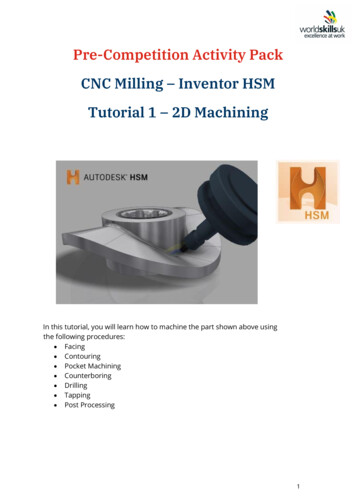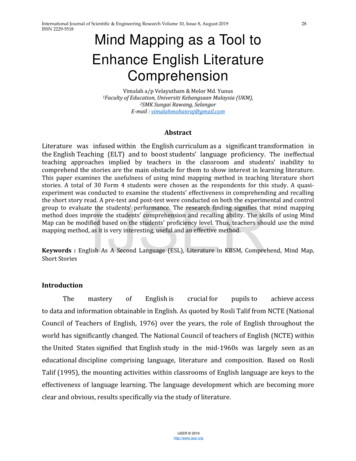
Transcription
International Journal of Scientific & Engineering Research Volume 10, Issue 8, August-2019ISSN 2229-551828Mind Mapping as a Tool toEnhance English LiteratureComprehension1FacultyVimalah a/p Velayutham & Melor Md. Yunusof Education, Universiti Kebangsaan Malaysia (UKM),2SMK Sungai Rawang, SelangorE-mail : vimalahmohanraj@gmail.comAbstractLiterature was infused within the English curriculum as a significant transformation inthe English Teaching (ELT) and to boost students’ language proficiency. The ineffectualteaching approaches implied by teachers in the classroom and students’ inability tocomprehend the stories are the main obstacle for them to show interest in learning literature.This paper examines the usefulness of using mind mapping method in teaching literature shortstories. A total of 30 Form 4 students were chosen as the respondents for this study. A quasiexperiment was conducted to examine the students’ effectiveness in comprehending and recallingthe short story read. A pre-test and post-test were conducted on both the experimental and controlgroup to evaluate the students’ performance. The research finding signifies that mind mappingmethod does improve the students’ comprehension and recalling ability. The skills of using MindMap can be modified based on the students’ proficiency level. Thus, teachers should use the mindmapping method, as it is very interesting, useful and an effective method.IJSERKeywords : English As A Second Language (ESL), Literature in KBSM, Comprehend, Mind Map,Short StoriesIntroductionThemasteryofEnglish iscrucial forpupils toachieve accessto data and information obtainable in English. As quoted by Rosli Talif from NCTE (NationalCouncil of Teachers of English, 1976) over the years, the role of English throughout theworld has significantly changed. The National Council of teachers of English (NCTE) withinthe United States signified that English study in the mid-1960s was largely seen as aneducational discipline comprising language, literature and composition. Based on RosliTalif (1995), the mounting activities within classrooms of English language are keys to theeffectiveness of language learning. The language development which are becoming moreclear and obvious, results specifically via the study of literature.IJSER 2019http://www.ijser.org
International Journal of Scientific & Engineering Research Volume 10, Issue 8, August-2019ISSN 2229-551829In the process of re-establishing English, the teaching and learning of literature hasemerged again in Malaysia, after its value has been unearthed and impressed upon. TheMinistry of Education proclaimed a major transformation into the policies of EnglishLanguage Teaching (ELT) policy. It is the infusion of literature as a part of theEnglish Language curriculum in secondary schools, as literature is to be inculcated as a partof English Language programme.This means that the teaching stylistics in the classroom would undergo somemodifications too. Literature was reintroduced to the Malaysian students in the year 2000and the first batch to implement this component was the Form 1 and Form 4 students. Itwas then followed by the Form2 and Form 5 students in the year 2001 and finally in theyear 2002 it was implemented to Form 3 students as well. This move makes the point thatthe study of literature benefits all learners of the language.IJSERAs stated by Raj & Hunt, (1990) in Gurnam Kaur Sidhu (2003), as a result of theimplementation of literature, schools have become aware of the consequence in learningliterature and are promoting effectual methods to develop the teaching and learning ofliterature. Literature consists of assorted parts like poems, plays, novels, short storiesand different genres. These are the ingredients that make the teaching and learning of thesecond language more fun.Literature also amplifies motivation to read among students; when they read a goodstory they enjoy reading it and want to know what happens next without worrying aboutthe linguistic difficulties. If a student can be so engrossed in short stories just by reading it,teachers can maintain the interest and create awareness in students who find literatureboring and burden to some.Short stories are part of the literature component and are implemented now inForm 1, Form 2 and Form 4. ‘Leaving’ by M G Vassanji and ‘Tanjong Rhu’ by Minfong Ho arethe two short stories to be covered as highlighted in the Form 4 English language syllabus.However, according to Koon (2003), teachers were caught unaware as literature inEnglish is totally a new thing to them. The situation occurs because there were no properguidelines to assist them. They have to teach the literature component using their ownpedagogical tools regardless of whether they were effective or not, for it is a compulsoryIJSER 2019http://www.ijser.org
International Journal of Scientific & Engineering Research Volume 10, Issue 8, August-2019ISSN 2229-551830element to be taught. However, for the students to perform their best, teachers use theeffective teaching techniques in the literature classroom. Listen in, read in and react tovarious texts, and express thoughts and feelings resourcefully in spoken and written formare the main objectives in the teaching and learning of short stories in the KBSM literatureelement.Despite the above deliberations and the emphasis on the importance of learningshort stories, the fact remains that there are still students who lack interest in this segment.In order to achieve the objectives and learning outcomes, the students must be able tounderstand and comprehend well the short stories read. The above elements can beachieved via the teachers’ effort and effective teaching techniques. Teaching and learningprocess will be more successful, self-governing and enjoyable when the appropriatetechnique is used to heave the students’ attention towards the lesson.IJSERFor students who enjoy reading and comprehending stories just by reading it,literature is just another story for them. However, for students who could not comprehendthe short story read, they struggle to perform their best and thus the objectives andlearning outcomes could not be achieved. They fail to focus and get bored with the lessonwhen they could not comprehend the literary text. Students disliked literature becausethey find it a difficult subject. Dull and boring lessons in class probably are one of the majorreasons why large number of students perceives literature as a boring, difficult andunexciting subject.An appropriate teaching method, which will enable the students to comprehend andrecall the short story better and faster without difficulty, is needed. Moreover, Madut &Yunus (2016), stated that using innovative material is an alternate and nontraditional waysof teaching which helps students to amass a good communicative competency withinthe targetlanguage. Itwill additionally bridgethegapbetweenthe classroomknowledge and students’ participation within the classroom. In order to implementeffective and suitable teaching techniques for most students, the researcher suggested theuse of Mind Map in learning literature short stories.A study on ‘Literature through Mind Maps’ has been done by Shameem Rafik-Galeaand Jasvir Kaur Sidhu in a secondary school and they found the students showedIJSER 2019http://www.ijser.org
International Journal of Scientific & Engineering Research Volume 10, Issue 8, August-2019ISSN 2229-551831improvement by reading better and Mind Map independently to reflect theirunderstanding. The aim of this study is to measure the effectiveness of using mind mappingin teaching literature short stories. The study is also set to analyze the English teachers’perception on this mind mapping method in the literature classroom.Literature ReviewLiterature in KBSM / KSSMThe English Language syllabus is planned according to the goals of the KBSM whichhas its concept of lifelong education. As found in KBSM (2000), its aims are also gearedtowards the progress of an ethically erect person who is assimilated intellectually,spiritually, emotionally and physically. It is also aimed to equip students with proficiency inEnglish Language in order for them to commune effectively. Literature component hasbeen added to the curriculum in a small portion. This new move is believed to triggerIJSERstudents’ interest in reading more enjoyable works and to use them as a vehicle tostrengthen their English language.The use of literature will help students to be imaginative and creative because theyare exposed to different genres of literature thus able to see the different linguisticelements and styles of writing. Even though it has been almost six years after theimplementation of literature in schools, there are still students facing difficulties with thiscomponent. This could result to the exam-oriented focus of the Malaysian education systemleaves most teachers with very little alternative, however to religiously prepare studentsfor the examinations ( Mastan, Maarof, and Embi, 2017 ).In order to motivate students towards literature, interesting, creative andinnovative teaching methods or techniques need to be carried out so that students will beable to comprehend the literary text well. Students must be able to remember theimportant issues or matters of the stories they have read in order to justify that they havemug the story well without any problem. In order to achieve this notion, our teachers aretrying their best to come out with an effective method to teach short stories, but we mustalways keep in mind that not all methods will show positive sign for every student isdifferent. So, we have to make sure that teachers are creative in using suitable resources inplanning their activity.IJSER 2019http://www.ijser.org
International Journal of Scientific & Engineering Research Volume 10, Issue 8, August-2019ISSN 2229-551832Comprehending Literary TextsComprehension elements address higher level thinking skills. It is referred to thestructure and elements of text such as plot, characters, and themes which are thefundamentals in short stories. Comprehension skill also requires students to analyze,interpret, conclude, and draw inferences relating them to their own experience andknowledge. Without understanding the stories read, the students will not be able tocontinue with the tasks listed above.The hitch of comprehending the stories read will lead to further problems such asstudents’ inability to identify, understand and interpret information read. Furthermore, itis a must for the students to be able to read between the lines and analyze the storiescritically. According to Mustapha (1998), a huge number of Malaysian students are passiveIJSERlearners. This is spot-on especially with those students from rural areas. With inadequatefacilities and unconducive environment in the rural area, pupils are becoming increasinglydependent on their teachers (Lim, Yunus, & Embi, 2017). As a step to improve this status,an appropriate approach on how to comprehend the underlying meaning of the literarytexts or short stories is crucial in teaching literature short stories.Techniques like using the Mind Map in teaching and learning literature short storiesis a good way of exposing students to effective method of comprehending the text or storiesread. This chapter will further explain on the usage of Mind Map and its benefits.Why We Should Use Mind Map?Tony Buzan develops Mind Map as a way of helping students to make notes usingkeywords and images. They are a lot of faster to form, and far easier to recollect andreview as a result of their visual quality and also the non-linear nature of Mind Map. MindMap is also said to be a structured strategy of note-taking which shows the connection ofideas in which students produce notes randomly on paper.Tony Buzan (2000), a popular psychology author describes Mind Map as a powerfulgraphic technique, which unlocks the ability of the brain using a general key. This methodIJSER 2019http://www.ijser.org
International Journal of Scientific & Engineering Research Volume 10, Issue 8, August-2019ISSN 2229-551833can be used by anyone in each facet of life wherever enhanced learning and clearerthinking can magnify human performance.Mind Map is the most user-friendly creative thinking tool given by Tony Buzan. Itsmain objective is to tap the way brain actually works. Mind mapping allows ideas to spreadout from a central focus while providing a holistic picture of the situation.As had been mentioned earlier, Mind Map is an effective note-taking method whichuses key words, lines, colours, images and other visual images as well. The mostcomprehensive note taking systems require attention on the students’ part. The mindmapping method will be a useful and helpful method to the students not only in the senseof note-taking but it will also enable the students to comprehend and remember thingsfaster and better. The benefits of Mind Map are plenty if it is used in a proper and anorganized way and it certainly believed to win as an effective method especially in theIJSERteaching and learning of literature short stories.Mind Map is chosen as an effective teaching, note-taking and brainstorming toolbecause it is better than planning in a linear way. A linear or in-a-line means that, writingthe introduction followed by the first paragraph’s topic sentence and then the sub-topics ofthe first sentence. It is then continued with other paragraphs and the conclusion. Thislinear method is not good for students as they cannot expand their ideas freely because theorder is decided before writing. So, if students change their mind or need to do correctionsor additions, they need to rewrite the whole text all over again. The situation differs if MindMap is used instead of the linear method. The students’ just need to pour out their ideas ona sheet of paper connecting to the main subject and finally decides the order of the ideas. Itis easier to go back to a Mind Map and add in or update than we can on linear form notes.Place an image in the center of a page and draw connectors extending out in all directionsfrom that image. Locate all those on the page in an associated network, and you’ve got aMind Map.In our focus which is literature short stories, how does a Mind Map helps incomprehending and remembering facts or important issues better and faster? Literature issomething different than other subjects. In literature, there is no wrong or right answer.You cannot say that your idea or opinion is correct and others are wrong. You can only sayIJSER 2019http://www.ijser.org
International Journal of Scientific & Engineering Research Volume 10, Issue 8, August-2019ISSN 2229-551834yours is better than others by providing relevant evidences. Students need to rememberthe evidences according to the situation required. However, even though critical andcreative thinking skills is not something new, our system has fallen short in generatingsuch students (Lim, Yunus, & Mohamad, 2016). Thus, how well can students do it withouthaving a proper thinking skill and ways to express them? And why there are still studentswhom dislike literature?Creative approaches to teaching literature do exist. It covers teachers’ way ofteaching creatively. If a teacher just teach his or her students in conventional ways, it islikely for students to just listen but not absorb the contents. One of the creative approachesintroduced here is the Mind Map for it brings out the internal thoughts of a student.Besides, the method should be student centered and no longer teacher centered. Just letour students to explore literature by themselves. Teacher should facilitate the studentsafter telling them what they should do.IJSERMind Map might seem to be childish to certain people for it is colourful, insertedwith images, arrows and other attractive symbols, but that is how the brain works andMind Map follows the way our mind thinks. Students will be amazed by the way Mind Mapworks for them.Applying Mind Map in the Teaching of LiteratureAccording to Kokila Amarnath in Reflections (September, 2003), methods used bythe teachers must be creative, exiting and motivating because in today’s scenario, teachesneed to cater children who get bored easily with the routine and mundane work. Themethods used must be able to break the monotony and motivate the students to participateactively in the lesson.Literature lessons require the students to remember certain issues from the story.So, note-taking will be easy and quicker to make through Mind Map. Using a completedMind Map, the students will find it easy to refer to the story. Recalling and revising thestory too will not be the major problems for the students. This is because the notes thatthey make are easy to be understood and they can edit it anytime they want. So, mindmapping will always be a useful and effective tool for teaching literature.IJSER 2019http://www.ijser.org
International Journal of Scientific & Engineering Research Volume 10, Issue 8, August-2019ISSN 2229-551835Previous Research DoneShameem Rafik-Galea and Jasvir Kaur had carried out a study on ‘TeachingLiterature through Mind Maps’ on Form 3 students. Their main aim of the study is toillustrate the use of Mind Maps in the literature class. The students responded well to thetechnique and they were able to relate to the characters and their Mind Maps clearlyreflected their understanding of what they have read. Having the study above as areference, the researcher will be using this technique on 30 Form 4 students via theexperimental method.MethodologyThis was a quasi-experimental research which was aimed to determine if the usageof Mind Map in teaching short stories enables the students to comprehend and recall thestory faster and also to examine the teachers’ perception concerning the use of Mind MapIJSERin teaching Literature short stories. This research was conducted on a group of Form 4students from a sub-urban school in the Sepang district.Questionnaire was also utilized to gather the English teachers’ perception towardsthe usage of mind mapping method in the literature classroom.This research was entirely based on the students’ performance.Research Design30 Form 4 students have participated in this research and all the students wererepresented from one class. A test was given to all the students and they were separatedinto control and experimental group according to the result of the test. This shows thatthere were 15 students in both the experimental and control group. The researcherselected the students from one class as the subjects in order to make the data collectioneasier and also enable the teacher to compare the result of the students individuallywithout much hassle.The method chosen for this study is a pre-test and post-test which was conductedon the selected subjects. Pre-test was given to both the experimental and control groupbefore the treatment in order to measure the students’ understanding and recalling abilityIJSER 2019http://www.ijser.org
International Journal of Scientific & Engineering Research Volume 10, Issue 8, August-2019ISSN 2229-551836on the latest short story learnt. As for the rest of the research, only the experimental groupstudents were exposed to the mind mapping method and in usage whilst the control groupwas required to continue their literature lessons as usual which was conducted by theirEnglish teacher. The reason is to see if there were any progresses due to the treatmentconducted towards the experimental group as well as to compare the findings with thecontrol group.Once the entire teaching process came to an end for that particular short story, apost-test was given to the students of both the experimental and control group.Questionnaires were also given to all the English Language teachers. The research designfor the research is shown as follow :GROUPIJSERTESTEXPERIMENTALGROUPCONTROL GROUPPRE-TESTPRE-TESTTREATMENTCONVENTIONAL METHODPOST-TESTPOST-TESTQUESTIONNAIREFigure 1: Research DesignFigure 1 shows that the chosen class was given a test before they were disseminatedinto experimental and control group. The test was to make sure that each group containsstudents of every level and thus it will provide the researcher a fair and reliable end result.IJSER 2019http://www.ijser.org
International Journal of Scientific & Engineering Research Volume 10, Issue 8, August-2019ISSN 2229-551837Once the students were separated according to their test result, a pre-test was given toboth the experimental and control group. This pre-test examined the students’ recallingability as well as the comprehension on a particular short story which they have alreadylearnt in their previous lessons. Next, the treatment on the use of Mind Maps in learningliterature short stories was given to the experimental group. Meanwhile the control groupcarried on their lessons with their normal schedule and learning method. Once the entiretreatment ended, a post-test was conducted to both the experimental and control groupwere evaluated to gain the outcome.The research was done with the help of the students’ English teacher during theexperiment. The researcher produced the activities to be given to the students throughoutthe treatment period as well as the test, pre-test and post-test.Findings and DiscussionIJSERThe scores obtained in the pre-test and the post-test for both the experimental andcontrol group were presented in the form of line chart. The purpose of using line chart is toshow clearly the comparison of results between the two tests for each student.The scores obtained from the tests given were interpreted in order to find outwhether the students’ understanding and recalling ability had improved after thetreatment. The pre-test scores were compared with the post-test in order to find out if thestudents achieved a better result after the treatment.Pre-Test and Post-Test Results of the Experimental GroupComparison between the Pre-Test and Post-Test ofExperimental Group5045Scores40353025Pre-Test20Post-Test151050S1 S2 S3 S4 S5 S6 S7 S8 S9 S10 S11 S12 S13 S14 S15IJSER 2019http://www.ijser.org
International Journal of Scientific & Engineering Research Volume 10, Issue 8, August-2019ISSN 2229-551838Figure 1.1 : Comparison between the Pre-Test and Post-Test of the Experimental GroupFigure 1.1 shows the results obtained by the students from the experimental groupfor the pre-test and the post-test. Fourteen out of fifteen students showed an increase intheir post-test performance. Mind mapping method really worked well on majority of thestudents for it is a fun-filled way of learning literature where the students create their ownshort notes based on the mind mapping rules. Similarly in Yunus (2016), by using the mindmapping strategy, the students’ have improved significantly in their ability to transfermeaning to write summaries; they were able to write more complete and well-organisedsummaries.Rather than reading and understanding someone else’s notes, students learnedmore effectively by using their own notes which were creatively done with pictures,IJSERcolours to differentiate main ideas, lines to radiate their ideas out and so on.Pre-Test and Post-Test Results of the Control GroupFigure 4.2 below shows us the result of the control group students whom were notexposed to the mind mapping method as the experimental group.ScoresComparison between the Pre-Test and Post-Test of The50454035302520151050Pre-TestPost-TestS1 S2 S3 S4 S5 S6 S7 S8 S9 S10 S11 S12 S13 S14 S15StudentsFigure 1.2 : Comparison between the Pre-Test and Post-Test of the Control GroupBased on the result gathered, a total of 10 students increased in their score but withvery few points. The mild increase exposed in the table above shows that the conventionalIJSER 2019http://www.ijser.org
International Journal of Scientific & Engineering Research Volume 10, Issue 8, August-2019ISSN 2229-551839method did work well on the students as their score did not show any drastic decreasefrom the pre-test result. Even though the students’ improvement was not marvelous, themild improvement cannot be denied.As shown in figure 1.2, most students scored better in the post-test compared to thepre-test. This shows that the control group students know how to skim and scan the storybut they have not improved well compared to the experimental group.The control group students also have improved but the progress is not as great asthe experimental group students. The improvement in the control group shows that thetraditional methods used by the teachers did work well on them but not as well as how themind mapping method did wonders to the experimental group.QuestionnaireIJSERThe questionnaire was used to gather information in order to answer the secondresearch question. The questionnaire was divided into three sections; Section A:Demographic Information, Section B: Teachers knowledge on Mind Map and Section C:Teachers’ Perception on the Usage of Mind Map in Teaching Short Stories.A total of 5 English teachers from SMK Sungai Rawang answered the questionnaire.All of them are TESL graduates and cooperated well in answering the questionnaire.Based on the findings from Section B, all the teachers have basic knowledge on MindMap but they seldom practice it in their lessons. Majority of the teachers have theexpectation that students know how to create a mind map on their own so they do not haveto expose them to a sample mind map or teach them how to do a mind map. However, theteachers also admit that the students should be taught on how to create a mind map forthey will not be confused with what they create in future.All the teachers agreed that mind map enables one to exploit the text read in depth.They also agreed that mind map will enable the students to have a clearer view on thecontent of the story and that they can understand the story or the content better. Also, ifthe students follow the techniques or guides provided on how to create a mind map, theywill end up with a perfect mind map and which will help them to comprehend and recallthe story better and faster.IJSER 2019http://www.ijser.org
International Journal of Scientific & Engineering Research Volume 10, Issue 8, August-2019ISSN 2229-551840The findings gained from Section C resulted in positive perception from theteachers. It illustrates that the teachers have a good perception on the usage of mind mapin teaching literature short stories. This also shows that they know the benefits of usingmind map in teaching short stories. The teachers agreed that students tend to be creativeand critical when using the mind mapping method through which they could comprehendbetter and faster. The students will be able to remember what they have read or presentedin mind map without difficulty. Thus this depicts that all the teachers find the mindmapping method as an effective one.ConclusionThe effectiveness of the mind-mapping method was shown in the results obtainedby the students in their post-test. This signifies that the method works to enhance students’understanding and recalling ability. The mind mapping method is apt to assist students inIJSERpreparing their writing as the technique enriches students to gain some profoundunderstanding of the writing topics.Future researchers are recommended to conduct similar study in a greater scopewithin a longer period of time. The reason is, it will provide a more valid and reliableoutcome. In addition, the treatment should also cover more short stories compared to onlyone done by researcher. This is to measure the students’ performance more accurately.REFERENCES1.Buzan,T.2000. The Mind Set: Use Your Head, Use Your Memory, Master Your Memory and the SpeedReading Book. All London: BBC Worlwide Limited.2.Buzan in Management Consulting News, 2006 found inhttp://www.managementconsultingnews.com3.Gurnam Kaur Sidhu. 2003. “Literature in the Language Classroom: Seeing Through the Eyesof Learners” In Subramaniam,G. The Teaching of Literature in ESL/EFL Contexts, Kuala Lumpur:SASBADI-MELTA.4.Kurikulum Bersepadu Sekolah Menengah (KBSM), 2000.5.Kokila Amarnath (September,2003) ‘Reflections’ found in6.Rosli Talif.1995. Teaching Literature in ESL: The Malaysian Context, Serdang, Selangor: PenerbitUniversiti Pertanian Malaysia.7.Sukatan Pelajaran Sekolah Menengah, 1992.IJSER orporate.com
International Journal of Scientific & Engineering Research Volume 10, Issue 8, August-2019ISSN 2229-5518418.“Teaching Literature Through Mind Maps” by Shameem Rafik-Galea and Jasvir Kaur.: http://www.melta.org.my/ET/2004/2004-12720049.Wong Soak Koon.2003. “ Journeying on the Less-Travelled Road of Literacy Analysis” InSubramaniam.G. The Teaching of Literature in ESL/EFL Contexts,Kuala Lumpur: 11.http://www.melta.com(Special Interest Group Forum:Literature helps to enhance students’ interest and appreciationEnglish)found intowards12.Madut, I.T. and Yunus, M.M., 2017, May. Popsicle Simile: An Innovative Tool in Promoting CreativeWriting among Rural Primary School ESL Learners. In International Conference on Education (ICE2)2018: Education and Innovation in Science in the Digital Era (pp. 425-431).13.Ien, L.K., Yunus, M.M. and Embi, M.A., 2017. Build me up: Overcoming writing problems among pupilsin a rural primary school in Belaga, Sarawak, Malaysia. Jurnal Pendidikan Humaniora. 5(1). pp.1-7.14.Mastan, M.E.B., Maarof, N. and Embi, M.A., 2017. The effect of writing strategy instruction on ESLintermediate proficiency learners’ writing performance. Journal of Educational Research and Review. 5(5).pp.71-78.15.Shan, P.L.M., Yunus, M.M. and Mohamad, M., 2018. The Malaysian education blueprint 2013 and itseffects on English language teaching in Malaysia. Asian EFL Journal. 20(7). pp.66-80.16.Yunus, M.M. and Chien, C.H., 2016.
review as a result of their visual quality and also the non-linear nature of Mind Map. Mind Map is also said to be a structured strategy of notetaking which shows the - connectionof ideas in which students produce notes randomly on paper. Tony Buzan (2000), a popular psychology
